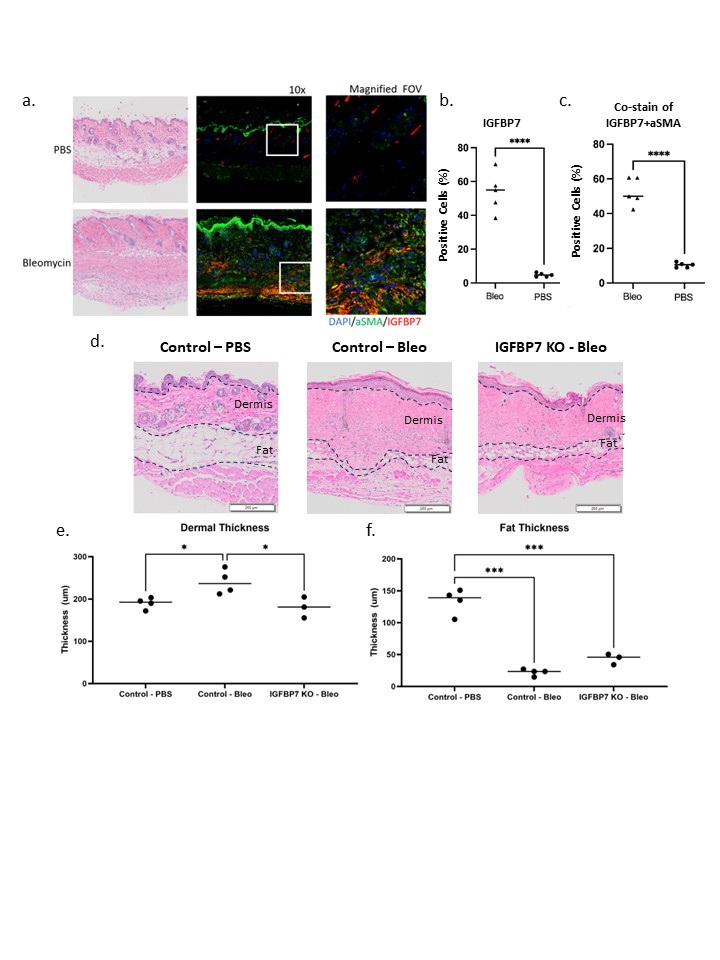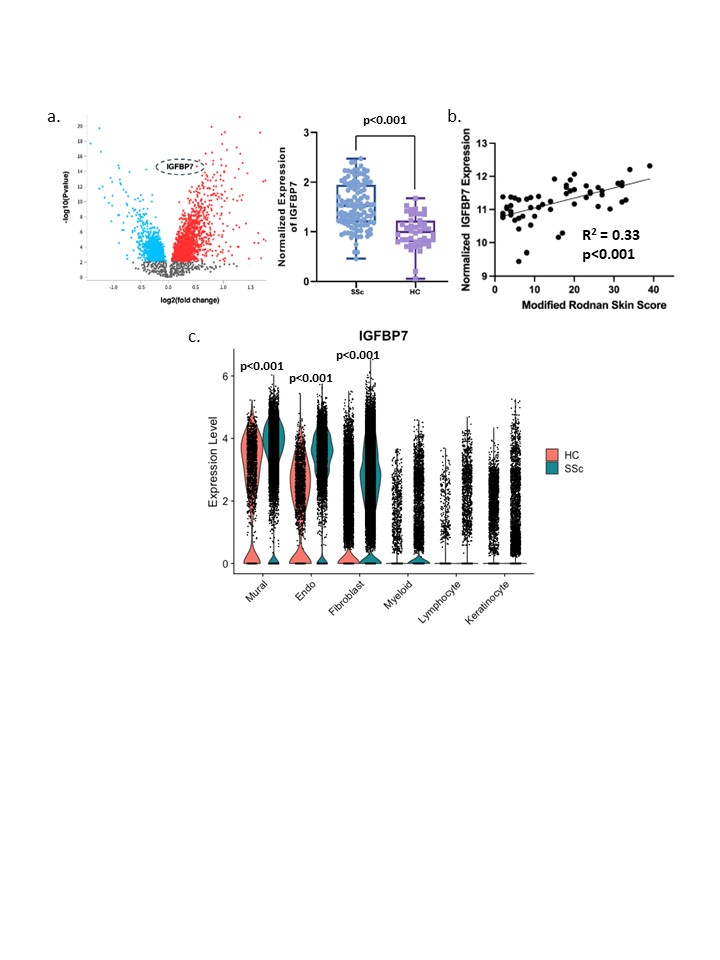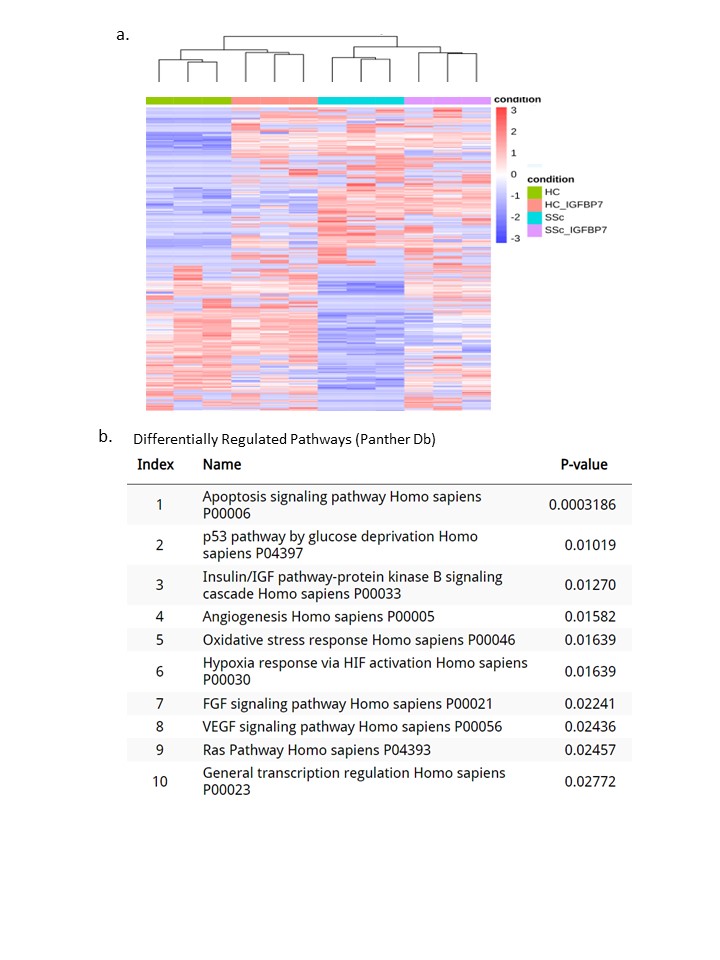Session Information
Date: Monday, November 18, 2024
Title: Systemic Sclerosis & Related Disorders – Basic Science Poster II
Session Type: Poster Session C
Session Time: 10:30AM-12:30PM
Background/Purpose: Systemic sclerosis (SSc, scleroderma) is an autoimmune connective tissue disease that causes autoimmunity, vascular dysfunction, and fibrosis of the skin, lungs, and other organs. Insulin-like growth factor binding protein 7 (IGFBP7) is a pleiotropic molecule that plays roles in IGF and insulin signaling, cellular senescence, and has recently been shown to drive fibrotic disease in the heart and the kidney. Intriguingly, IGFBP7 is a sensitive serum biomarker for the detection and severity of SSc-associated pulmonary hypertension. We hypothesize that IGFBP7 plays a pathogenic role in scleroderma by directing distinct molecular pathways which drive fibrosis.
Methods: C57BL/6J mice were subcutaneously injected with bleomycin (bleo) to study dermal fibrosis. Skin sections were stained by immunofluorescence to quantify cells positive for IGFBP7 and co-localization of aSMA and IGFBP7. IGFBP7-KO mice (IGFBP7fl/fl/mTmG-Cre) were generated, and bleomycin was administered to these animals, and skin was assessed for dermal and subcutaneous adipose thickness. To assess the relevance in human disease, publicly available microarray (GSE181549, GSE47162) and single cell RNA-seq (GSE249279) data from SSc patients were analyzed. To address IGFBP7’s mechanism in fibroblasts, bulk RNA-seq was performed on SSc and healthy human dermal fibroblasts cultured with and without 30ng/mL of IGFBP7. Lastly, primary fibroblasts were cultured with IGFBP7, TGF-b1, or both to assess IGFBP7’s effect under fibrotic conditions. Expression of genes involved in fibrotic and senescence pathways were assessed using qPCR.
Results: Increased expression of IGFBP7 and co-localization of IGFBP7 and aSMA in fibrotic skin was observed in mice treated with bleomycin (Fig 1a-c). IGFBP7 knockout mice had significantly decreased dermal thickness (Fig 1d-f). Analysis of GEO datasets revealed that IGFBP7 was significantly upregulated in patients (Fig 2a, p< 0.001) and displayed positive correlation with Modified Rodnan Skin Score (Fig 2b, R2=0.33). This finding was corroborated by single cell RNA-seq which showed IGFBP7 expression is restricted to endothelial, fibroblast, and mural cells and increased in SSc (Fig 2c). When skin fibroblasts were cultured with IGFBP7, they had higher expression of genes that are responsible for apoptosis, p53 signaling, angiogenesis, and oxidative stress (Fig 3). Lastly, scleroderma fibroblasts that were cultured with both IGFBP7 and TGF-b1 demonstrated an elevated expression of genes implicated in myofibroblast differentiation and senescence relative to either treatment alone.
Conclusion: IGFBP7 is expressed in fibroblasts, endothelial, and mural cells and is increased in fibrotic skin in both SSc patients and mice treated with bleomycin. Increased IGFBP7 correlates with severity of SSc skin disease. IGFBP7 loss-of-function significantly ameliorates dermal fibrosis. Fibroblasts cultured with IGFBP7 displayed alterations in pathways including apoptosis, p53 signaling, angiogenesis, and oxidative stress. When co-treated with both IGFBP7 and TGF-b, SSc fibroblasts were more likely to express genes indicating myofibroblast transition and cellular senescence.
To cite this abstract in AMA style:
Jeong Y, Guru Murthy G, Wang G, Rahman T, Korman B. Insulin-like Growth Factor Binding Protein-7 (IGFBP7) Plays a Pathogenic Role in Dermal Fibrosis and Is Increased in Systemic Sclerosis [abstract]. Arthritis Rheumatol. 2024; 76 (suppl 9). https://acrabstracts.org/abstract/insulin-like-growth-factor-binding-protein-7-igfbp7-plays-a-pathogenic-role-in-dermal-fibrosis-and-is-increased-in-systemic-sclerosis/. Accessed .« Back to ACR Convergence 2024
ACR Meeting Abstracts - https://acrabstracts.org/abstract/insulin-like-growth-factor-binding-protein-7-igfbp7-plays-a-pathogenic-role-in-dermal-fibrosis-and-is-increased-in-systemic-sclerosis/



